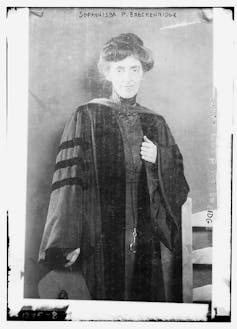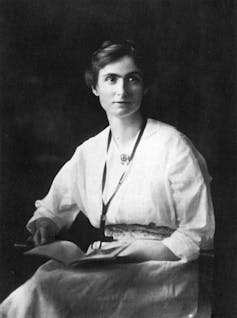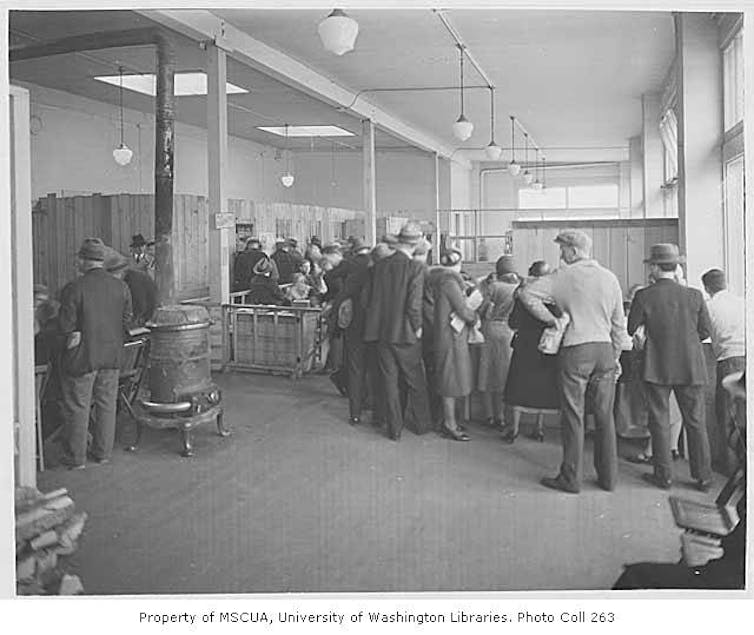Since openly gay South Bend, Indiana, Mayor Pete Buttigieg announced his bid for the presidency, news outlets have been full of stories about Buttigieg and his husband.
By highlighting the novelty of an out presidential candidate, such stories obscure the long participation of LGBTQ people in American politics.
U.S. history is full of examples of politically active people in same-sex relationships. As I discuss in my forthcoming book, Edith Abbott and Sophonisba Breckinridge were one such couple.
‘A life partnership’
Breckinridge and Abbott met in 1903 at the University of Chicago, one of the first U.S. universities to admit women to graduate programs.
Breckinridge earned her doctorate in political science in 1901 and a law degree in 1904; Abbott completed her doctorate in political economy in 1905.
In 1908, the two women joined forces at the Chicago School of Civics and Philanthropy, where they became pioneers in the new profession of social work. At the same time, they formed a close, personal relationship.
 Sophonisba Breckinridge. George Grantham Bain Collection (Library of Congress)
Sophonisba Breckinridge. George Grantham Bain Collection (Library of Congress)
Looking back on that pivotal period in their lives and careers, a former student mused: “I wonder if they foresaw that they were starting a life partnership that would enrich their personal lives and make their professional careers so intertwined that they would always be thought of together.”
Advocates for public welfare
For 40 years, Abbott and Breckinridge conducted social science research and promoted social welfare policy at both the state and the national level.
In Illinois, they used research on Chicago’s Juvenile Court to promote the nation’s first “mothers’ pension” program. Established in 1910, the program provided financial support for single mothers and their children.
In 1920, they co-founded the University of Chicago’s School of Social Service Administration, the nation’s first social work program affiliated with a research university.
Working closely with the U.S. Children’s Bureau, a federal child welfare agency established in 1912, they made the school a platform to promote public welfare policy at the national level.
Breckinridge and Abbott conducted studies of state welfare programs for the Children’s Bureau. They also promoted its innovative programs, including the Sheppard-Towner Act, which provided federal funding for health care for poor women and their children between 1921 and 1929.
Staffed and led by women – including Abbott’s sister, Grace Abbott – the agency functioned as a “female dominion” in American government.
 Edith Abbott. Wikimedia Commons
Edith Abbott. Wikimedia Commons
Responding to the Great Depression
When the nation plunged into the Great Depression, Abbott and Breckinridge focused their attention on national policies.
Breckinridge agonized over the plight of poor Americans. Years later, in a letter to Abbott, one of their former students vividly recalled a remark Breckinridge made about “being so troubled sleeping in her good warm bed. She seriously thought that she really ought to give it to someone who needed it, when the need was so dire and so widespread.”
In their journal, the Social Service Review, Abbott and Breckinridge called attention to “the inadequacy of private relief” and asserted that “federal aid” was “clearly necessary in this emergency.” They demanded “national funds for a national crisis.”
In 1931, they launched a study of the Chicago Renters’ Court, which heard cases in which tenants were subject to eviction for nonpayment of rent. They used evidence from this study to advocate for federal relief for impoverished Americans.
In her memoirs, Abbott maintained that Colorado Sen. Edward Costigan’s inspiration for the nation’s first federal relief bill was a conversation he had about homelessness in Chicago with her and her sister in the summer of 1931.
“Our schools are full of hungry children, our streets are full of tired and resentful men,” Abbott told Costigan. “The Renter’s Court,” she continued, “was a nightmare —- women crying, children crying, everyone in despair.”
Breckinridge gave Costigan evidence that he presented in Senate hearings on proposed relief legislation to fund public work projects and provide direct assistance to destitute citizens.
Abbott also testified on behalf of Costigan’s proposed legislation. Calling attention to the shortcomings of state programs, she asserted that “the science of social welfare” demonstrated the need for “a national system” in order “to take care of all the people who must have care.”
The Federal Emergency Relief Act was passed in 1933. It provided federal funding for both work-relief programs and direct financial assistance for needy Americans.
The new agency created by the act then hired Breckinridge to supervise a national program to train the first generation of federal public welfare workers.
Promoting the Social Security Act
Abbott and Breckinridge were long-standing advocates of what Breckinridge called a “national minimum” standard of living guaranteed by the federal government.
After Franklin D. Roosevelt’s election in 1932, Breckinridge and Abbott joined a powerful “women’s network” of female New Dealers that included first lady Eleanor Roosevelt, Secretary of Labor Frances Perkins and Democratic Party insider Mary W. Dewson. The two used their connections with this group and with the Children’s Bureau to advance their aim of creating a comprehensive welfare state.
As Abbott explained in an article published in The Nation in 1934, a “comprehensive plan” for social welfare should provide “adequate dignified relief for all in need.”
Abbott and Breckinridge worked with members of Roosevelt’s Committee on Economic Security, created in 1934 to design what would become the Social Security Act, which laid the groundwork for the modern welfare state, including unemployment insurance and old age insurance – now commonly referred to as “Social Security.”
Breckinridge and Abbott helped draft the child welfare portions of the bill. They promoted a new federal program, modeled on “mothers’ pensions,” which became Aid to Dependent Children (later Aid to Families with Dependent Children). They also supported new federally funded programs to provide health care and financial support for poor and disabled children.
Breckinridge dubbed the day that Roosevelt signed the Social Security Act, August 14, 1935, “the great date of the decade.” Breckinridge was immediately invited to join an advisory committee to oversee the act’s child welfare programs.
When Breckinridge was asked if she would be willing to attend the inaugural meeting of the committee at her own expense, she responded: “I think that I would crawl on hands and knees if it were necessary to try to be of service in connection with the Security Program!”
 Food bank interior, King County, Washington, ca. 1934. Federal Emergency Relief Administration Photographs, University of Washington Libraries
Food bank interior, King County, Washington, ca. 1934. Federal Emergency Relief Administration Photographs, University of Washington Libraries
‘What a pair!’
Abbott and Breckinridge never held political office. Nonetheless, they made their mark on public policy. Frank Bane, the first executive director of the Social Security Board (1935-1938), paid tribute to their partnership.
“In setting up the various relief administrations and Social Security, it was Edith Abbott with Sophonisba and a few others who gave us the greatest help,” he reflected. “Edith and Sophonisba – as the University of Chicago called them, A and B. – what a pair!”
Abbott and Breckinridge were not “out” as we now understand it, but neither were they “in the closet.” Rather, as was common during their lifetimes, their contemporaries acknowledged their relationship without labeling them lesbians.
After Breckinridge’s death in 1948, Abbott received a flood of condolence letters praising the women’s partnership. Many pointed out that the couple’s personal relationship enhanced their political efficacy. As Edna Zimmerman, the state superintendent for child welfare in Illinois, put it: “You and she have shared a common lot these many years and your labors in behalf of human welfare have borne rich fruit.”
Suffrage to civil rights
The Buttigiegs belong to a long tradition of LGBTQ political engagement.
Lesbians played a key role in both the suffrage movement and the New Deal. Gay men led the 1934 Longshoremen’s Strike in California; Bayard Rustin, who later became a gay rights activist, was Dr. Martin Luther King’s chief strategist in the movement for African American civil rights.
Abbott and Breckinridge’s personal and political partnership offers just one example of the longstanding contributions of LGBTQ people to American politics.
Source: World Politics - www.independent.co.uk


